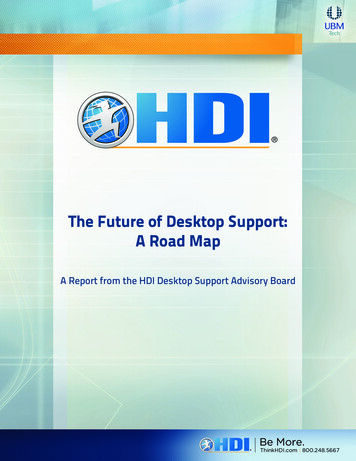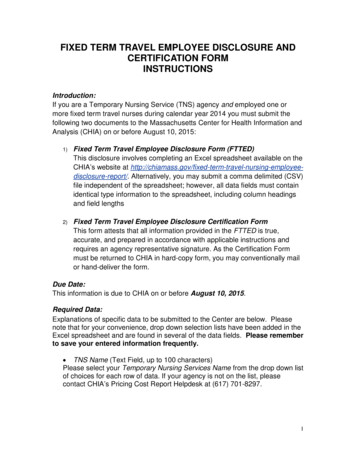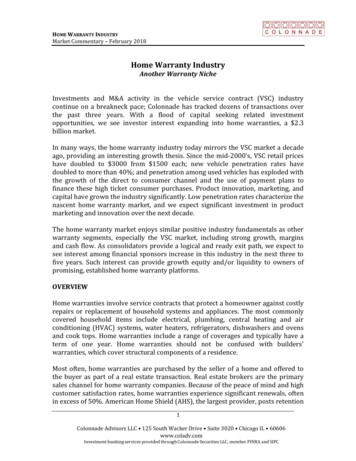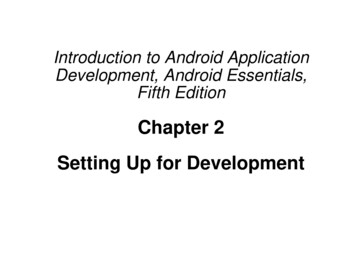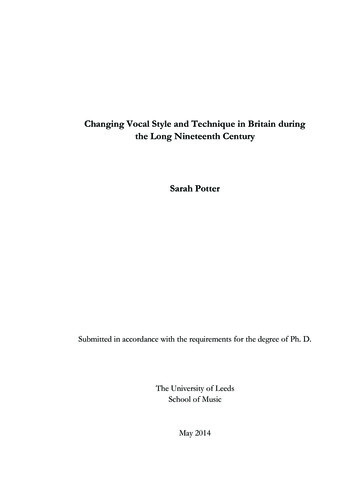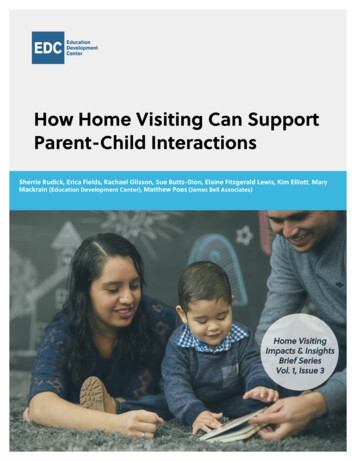
Transcription
How Home Visiting Can SupportParent-Child InteractionsSherrie Rudick, Erica Fields, Rachael Glisson, Sue Butts-Dion, Elaine Fitzgerald Lewis, Kim Elliott, MaryMackrain (Education Development Center), Matthew Poes (James Bell Associates)Home VisitingImpacts & InsightsBrief SeriesVol. 1, Issue 3
2020 Education Development CenterThis document is based on work prepared for the U.S. Department of Health and Human Services(HHS), Health Resources and Services Administration (HRSA), by Education Development Centerunder HRSA contract number HHSH2502014000471/HHSH25034002T. With attribution to theauthors and EDC, this brief may be used and distributed without permission for educational, noncommercial purposes, but cannot be sold or republished without written permission.Suggested Citation: Rudick, S., Fields, E., Poes, M., Glisson, R., Butts-Dion, S., Fitzgerald Lewis, E.,Elliott, K., & Mackrain, M. (2020). How Home Visiting Can Support Parent-Child Interactions.Home Visiting Impacts & Insights Brief Series, 1(3). Waltham, MA: EDC.EDC designs, implements, and evaluates programs to improve education, health, and economicopportunity worldwide. For more information, visit edc.org.
Table of ContentsOverview of Home Visiting . 2What is Parent-Child Interaction and Why Is It Important?. 3Why Does Home Visiting Focus on PCI?. 4Barriers to Supporting PCI in Home Visiting Programs . 4Overcoming Barriers: What Home Visiting Programs Can Do . 5Resources . 6Conclusion .7References .7EDUCATION DEVELOPMENT CENTER1
Overview of Home VisitingHome visiting programs build on the strengths of pregnant women and families byproviding resources and support focused on promoting physical, social, and emotionalhealth and ensuring children are ready to thrive in school (Health Resources & ServicesAdministration, Maternal & Child Health Bureau, n.d.a.). Today’s programs have theirroots in the settlement house and public health nursing movements. In the earliestdays, private charities supported home visiting. Government funding increased forhome visiting from the early 1900s to the 2000s, and programs focused on health care.In the mid-1960s, home visiting programs expanded to respond to poverty, meet theneeds of teen parents, and enhance the well-being of low birthweight babies (Finello& California Center for Infant-Family and Early Childhood Mental Health, 2012). By theend of the 20th century, home visiting was viewed as a promising approach to buildingknowledge of effective parenting and child development and preventing child abuseand neglect (Duffee et al., 2017). In 2010, home visiting got a tremendous boost whenthe Patient Protection and Affordable Care Act established the Maternal, Infant, andEarly Childhood (MIECHV) Program.MIECHV supports voluntary home visiting services for expectant parents and parentswith young children from birth to age 5 in communities that have been identified as highneed. The program’s design draws upon a substantial base of research demonstratingthat home visits by a trained professional during pregnancy and in the first years of achild’s life improve the lives of children and families (U.S. Department of Health &Human Services—HHS, Administration for Children & Families, 2020). Home visitinghelps supports positive parenting, improves maternal and child health, promotes childdevelopment and school readiness, and helps prevent child neglect and abuse.The MIECHV program is administered by the Health Resources and ServicesAdministration (HRSA) in partnership with the Administration for Children and Families(ACF). HRSA funds implementation of the MIECHV program in all 50 states and in 6jurisdictions. States and jurisdictions engage with local agencies to provide homevisiting services in communities that have been identified as high need. Each state orjurisdiction selects one or more among the approved, evidence-based home visitingmodels that may be implemented by the local agencies. There are currently 20 modelsthat meet HHS and legislative criteria for evidence of effectiveness as evaluated byHome Visiting Evidence of Effectiveness (HOMVEE), and HOMVEE has the responsibilityfor reviewing home visiting models to make sure they meet the criteria.Families enrolled in home visiting programs face many challenges and administeringa home visiting program is complex. MIECHV programs are required to prioritizeserving populations including, but not limited to, families with incomes at or belowEDUCATION DEVELOPMENT CENTER2
100 percent of the Federal Poverty guidelines, pregnant teens, families with a historyof child neglect or abuse, families with a history of substance misuse, and militaryfamilies (Adelstein et al., 2019; Health Resources & Services Administration, Maternal& Child Health Bureau, n.d.a.).What is Parent-Child Interaction and Why Is It Important?One of the best ways to understand parent-child interaction (PCI) and the vital role itplays in children’s healthy development is to explore the Still Face Experimentconducted by Dr. Edward Tronick. This powerful two-minute videoclip clearly andcompellingly captures the importance of PCI. At the beginning of the clip, themother and baby are engaging in a back-and-forth non-verbal interaction,communicating through gestures, facial expressions, smiles, eye contact. In the nextpart of the experiment, the mother is asked to stop her non-verbal responses to thebaby and present a still, unmoving, non-reactive face. Within seconds, the babyexhibits signs of distress. She screeches, tries to reengage the mother, and, failing todo so, grows increasingly stressed. Fortunately, in the videoclip, the motherreengages, and the baby’s sense that the world is okay is restored.More commonly thought of as the parent-child relationship, PCI is one of the mostkey dynamics between a parent and child. The parent-child relationship is theconduit through which parents influence their children’s cognitive, academic, social,and emotional development. The parent and child each provide cues to which theother responds. This dyadic interaction, which combines behaviors, emotions, andexpectations, is a critical part of children’s formative years and is primarilyresponsible for setting the stage for nearly all aspects of a child’s development intoadulthood (O’Connor, 2002).Early experiences are crucial to how a child develops and learns. The foundations forhealthy adulthood are laid in the early years. Early brain development is critical toforming connections needed for development into the future. Positive parent childinteraction impacts how a child’s brain develops. Young children’s brains arebuilding synaptic connections at a rapid rate. We know that by age 3, 80% of thesynaptic connections are made. By the time we hit our 20’s, brain growth levels offand pruning begins (The Urban Child Institute, n.d.). Experiences define the wiring ofan infant’s brain. Children who experience positive nurturing interactions withparents in infancy and early childhood, develop strong and positive attachments andare significantly better prepared to succeed in school (Center on the DevelopingChild, 2017). There is no such thing as spoiling a young child. There is no such thingas a manipulative one year old. No amount of warm responsive care is too much. Infact, the absence of such care can lead to anxiety and depression.EDUCATION DEVELOPMENT CENTER3
Why Does Home Visiting Focus on PCI?Home visiting has the potential to have a strong positive impact on how parents andchildren interact. One of the central tenets of home visiting is a focus on building onparents’ strengths and supporting them in their vital roles as the primary influencersof their children’s development. Research has shown that improvements in PCI arepossible and lead to enhanced child development and family functioning. Fifteen ofthe 20 approved evidence-based home visiting models include a parentingcomponent and have been found to have a positive impact on parenting practices(Sama-Miller et al., 2017); strengthening PCI is the main focus of some of theseprograms (Peterson et al., 2018.)Additionally, improvement in PCI has been shown to reduce the likelihood of childmaltreatment (Batzer et al., 2018). Parents with warm and attentive parenting stylesmay be more attuned to their children’s needs, their stress may be reduced, andtheir reactions may be more positive when responding to difficult child behaviors.Finally, parents who are more attuned to their children may also spend more timewith them and may be more aware of their needs. This may reduce the chance ofparent neglect. Home visitors’ close and supportive relationships with families allowthem to observe PCI, identify stressors for parents and children, and provide timelyresources and support.Barriers to Supporting PCI in Home Visiting ProgramsBarriers on many levels affect the ability of home visitors to engage parents insupportive interventions that encourage positive PCI. Some of the more prevalentbarriers include: Emotional Stress – Unsafe environments, limited resources, family illness,and unstable housing are just a few of the daily stressors parents enrolled inhome visiting programs experience (Beasley et al., 2014; Han et al., 2017;Rostad et al., 2018; Wilson et al., 2019). Home visitors are impacted emotionallyas they support families, try to navigate how much of a PCI interventionprogram to implement, and how to do it amid challenging times for families(Wilson et al., 2019). Dealing with immediate crises may leave little time forobserving parent-child interaction (Nygren et al., 2018).Skills – The complexity involved in working to improve parenting skillsrequires that home visitors have the skills to recognize and capitalize oninteraction opportunities (Peterson et al. 2018). Some home visitors haveinsufficient training on a variety of topics, including PCI (Paulsell et al., 2014).EDUCATION DEVELOPMENT CENTER4
Time/Scheduling – Lack of time and challenges with scheduling are barriersfor both parents and home visitors. For parents, the time to engage in homevisiting at all can seem unrealistic (Beasley et al., 2014; Han et al., 2016; Rostadet al., 2018). The time-consuming nature of paperwork and documentation is areal challenge to home visitors (Wilson et al., 2019). This is especially true whenthey are expected to implement multiple programs (e.g., a home visitingprogram and a parenting intervention) and must balance their time betweenthe two (Han et al., 2017).Virtual Visits – A previously unanticipated barrier arose when the COVID-19pandemic caused many home visiting programs to switch to virtual visits.Supporting families virtually limits a home visitors’ ability to observe andinteract with families within their home where parenting is happening allaround them, and not just in front of the camera.Mental Health – When parents experience mental health challenges, it can bedifficult for them to focus on parent-child interactions. This raises the questionof whether parents who are experiencing depression, substance misuse, orother mental health challenges will need support with these issues before thefamily can benefit from parenting interventions (Batzer et al., 2018; McKelveyet al., 2018; Pecora et al. 2014).Overcoming Barriers: What Home Visiting Programs Can DoDespite the barriers, home visitors are in an especially good position to providesupport around parent-child interaction. Home visiting programs and home visitorsare most effective at supporting parent-child interaction when they: Provide professional development – It’s important to engage bothsupervisors and home visitors in professional learning experiences focused onchild development, cultural beliefs, observation skills, training on theprogram’s observation tool, and strategies to support parent-childinteractions and attachment. Professional development is most effective whenit supports implementation of practices learned in professional developmentthrough reflective supervision and coaching (Han et al., 2016; Paulsell et al.,2014; Peterson et al., 2018).Help home visitors understand the importance of PCI – When home visitorsunderstand why they are observing parent-child interaction and how whatthey learn from their observations can change how parents interact with theirchildren, they are more likely to observe parent-child interactions and to helpparents build their skills in relating to their children (McKelvey et al., 2018;Peterson et al., 2018).EDUCATION DEVELOPMENT CENTER5
Use proven strategies – Techniques such as in-the-moment feedback,modeling, and coaching can be particularly helpful in building parents’ skills(Han et al., 2016; Peterson et al., 2018). It is also helpful to teach skills such aslistening attentively; responding at the child’s own level of understanding withenthusiasm, warmth, and genuineness; supporting the child’s problemsolving efforts; and encouraging creativity. This strategy, however, is morechallenging when home visits are conducted virtually.Record PCI – Analyzing video recordings can provide an objective view ofinteractions and help improve the reliability and quality of observations andassessments of parent-child interactions. Combined with policies that explainto both parents and home visitors why video recordings are being used,videos can be a coaching tool for parents and an effective training tool forhome visitors (Peterson et al., 2018).ResourcesThe following articles, toolkits, and briefs provide strategies to support parent-childinteractions. Co-Regulation from Birth through Young Adulthood – Provides guidelines foreffective co-regulation support at each stage of a child’s development. Parenting Knowledge among First-time Parents of Young Children – Presentsfindings from Child Trends’ study of first-time parents of young children(under age 3) and their knowledge about parenting and child development. Positive Parent Child Relationships – Summarizes research, proveninterventions, and program strategies to support parent child relationships. Promoting Self-Regulation in the First Five Years – Describes the importanceof self-regulation and provides strategies to support infants’ and youngchildren’s development of self-regulation. Self-Regulation Snap Shot #1: A Focus on Infants and Toddlers and SelfRegulation Snap Shot #2: A Focus on Preschool Age Children – Summarizesthe key concepts of self-regulation development and provides an overview ofinterventions for practitioners and educators. Three Principles to Improve Outcomes for Children and Families – Outlineskey principles of helping build young children’s healthy brains and bodies:support responsive relationships for children and adults, strengthen core lifeskills, and reduce sources of stress in the lives of children and families.EDUCATION DEVELOPMENT CENTER6
Why Becoming a Good Parent Begins in Infancy – Offers a quick primer tofamily and community members, professionals, and policymakers on how theavailability and quality of personal relationships are vital to the emotional anddevelopmental growth of a child.ConclusionParent-child interactions lay the foundation for children’s development and learning.Nurturing and stable relationships between babies and parents boost braindevelopment in the early years, help children develop a positive sense of self, andbuild their social skills. Healthy social and emotional development supports selfregulation, strong cognitive development, resilience, and school readiness. Homevisitors have a unique opportunity to support the parent/child relationship as theysustain long-term relationships with parents and use their ongoing home visits tobuild on families’ strengths and support families in fostering children’s healthy socialand emotional development.ReferencesAdelstein, S., Longo, F., & Shakesprere, J. (2019, March). Home visiting for militaryfamilies: An overview of innovative programs. National Home Visiting ResourceCenter Innovation Roundup Brief. Arlington, VA: James Bell Associates and UrbanInstitute. https://go.edc.org/MilitaryFamiliesBatzer, S., Berg, T., Godinet, M. T., & Stotzer, R. L. (2018). Efficacy or chaos? Parent–child interaction therapy in maltreating populations: A review of research.Trauma, Violence, & Abuse, 19(1), 3–19. https://doi.org/10.1177/1524838015620819Beasley, L. O., Silovsky, J. F., Ridings, L. E., Smith, T. J., & Owora, A. (2014).Understanding program engagement and attrition in child abuse prevention.Journal of Family Strengths, 14(1), 20. http://go.edc.org/FAMCenter on the Developing Child at Harvard University. (2017). Three Principles toImprove Outcomes for Children and ro, D., Klein, S., & Burkhardt, T. (2017). The Pew Home Visiting Data forPerformance Initiative: Phase II Final Report on Parental Capacity and ChildDevelopment Indicators. http://go.edc.org/PewHVDataDuffee, J. H., Mendelsohn, A. L., Kuo, A. A., Legano, L. A., & Earls, M. F. (2017,September). Early childhood home visiting. Pediatrics, 140(3).https://go.edc.org/PediatricsEDUCATION DEVELOPMENT CENTER7
Finello, K. M., & California Center for Infant-Family and Early Childhood MentalHealth. (2012). A brief history of home visiting in the United States.https://go.edc.org/HVHistoryHan, M., Hallam, R., Hustedt, J. T., Vu, J. A., & Gaviria-Loaiza, J. (2016). Lessons fromtraining Early Head Start Staff to implement an evidence-based parentingintervention. NHSA Dialog, 19(3). http://go.edc.org/HSHanlon-Dearman, A., Malik, S., Wellwood, J., Johnston, K., Gammon, H., Andrew, K.N., . & Longstaffe, S. (2017). A descriptive study of a community-based homevisiting program with preschool children prenatally exposed to alcohol. Journal ofPopulation Therapeutics and Clinical Pharmacology, 24(2), ticle/view/14Health Resources & Services Administration, Maternal & Child Health Bureau.(n.d.a.). Home visiting. https://go.edc.org/HomeVisitingOverviewHiratsuka, V. Y., Parker, M. E., Sanchez, J., Riley, R., Heath, D., Chomo, J. C., . &Sarche, M. (2018). Cultural adaptations of evidence‐based home‐visitation modelsin tribal communities. Infant Mental Health Journal, 39(3), ey, L. M., Fitzgerald, S., Edge, N. A. C., & Whiteside-Mansell, L. (2018). Keepingour eyes on the prize: focusing on parenting supports depressed parents’involvement in home visiting services. Maternal and Child Health Journal, 22(1),33–42. , J. A., & Mastergeorge, A. M. (2014). A meta‐analytic review of relationship‐based interventions for low‐income families with infants and toddlers: Facilitatingsupportive parent–child interactions. Infant Mental Health Journal, 35(4), 336–353. https://doi.org/10.1002/imhj.21451Nygren, P., Green, B., Winters, K., & Rockhill, A. (2018). What’s happening duringhome visits? Exploring the relationship of home visiting content and dosage toparenting outcomes. Maternal and Child Health Journal, 22(1), ’Connor, T. G. (2002). Annotation: The “effects” of parenting reconsidered:Findings, challenges, and applications. Journal of Child Psychology andPsychiatry, 43, 555–572.Paulsell, D., Del Grosso, P., & Supplee, L. (2014). Supporting replication and scale-upof evidence-based home visiting programs: Assessing the implementationknowledge base. American Journal of Public Health, 104(9), 62Pecora, P. J., Sanders, D., Wilson, D., English, D., Puckett, A., & Rudlang‐Perman, K.(2014). Addressing common forms of child maltreatment: Evidence‐informedEDUCATION DEVELOPMENT CENTER8
interventions and gaps in current knowledge. Child & Family Social Work, 19(3),321–332. https://doi.org/10.1111/cfs.12021Peterson, C. A., Hughes-Belding, K., Rowe, N., Fan, L., Walter, M., Dooley, L., . &Steffensmeier, C. (2018). Triadic interactions in MIECHV: Relations to home visitquality. Maternal and Child Health Journal, 22(1), stad, W. L., Moreland, A. D., Valle, L. A., & Chaffin, M. J. (2018). Barriers toparticipation in parenting programs: the relationship between parenting stress,perceived barriers, and program completion. Journal of Child and Family Studies,27(4), 1264–1274. er, E., Akers, L., Mraz-Esposito, A., Zukiewicz, M., Avellar, S., Paulsell, D., &Grosso, P. D. (2017). Home visiting evidence of effectiveness review: Executivesummary. Mathematica Policy Research. http://go.edc.org/ExecsummThe Urban Child Institute. (n.d.). Baby’s brain begins now: Conception to age 3.http://go.edc.org/UrbanU.S. Department of Health & Human Services, Administration for Children &Families. (2020). What is home visiting evidence of effectiveness?https://go.edc.org/HomveeWilliamson, A. A., Knox, L., Guerra, N. G., & Williams, K. R. (2014). A pilot randomizedtrial of community-based parent training for immigrant Latina mothers. AmericanJournal of Community Psychology, 53(1-2), 47–59. https://doi.org/10.1007/s10464013-9612-4Wilson, K., Robinson, C., Donahue, A., Hall, M., Roycraft, N., & Barron, C. (2019).Experiences of infant mental health home visiting professionals in challengingand high-risk environments. ZERO TO THREE, 39(6), 5–11.https://go.edc.org/ExperiencesEDUCATION DEVELOPMENT CENTER9
EDC 43 Foundry Avenue, Waltham, MA 02453Phone: 617-969-7100Boston Chicago New York Washington, orldwidego.edc.org/linkedin
& California Center for Infant-Family and Early Childhood Mental Health, 2012) . By the end of the 20th century, home visiting was viewed as a promising approach to building knowledge of effective parenting and child development and preventing child abuse and neglect ( Duffee et al., 2017). In 2010, home visiting got a tremendous boost when

